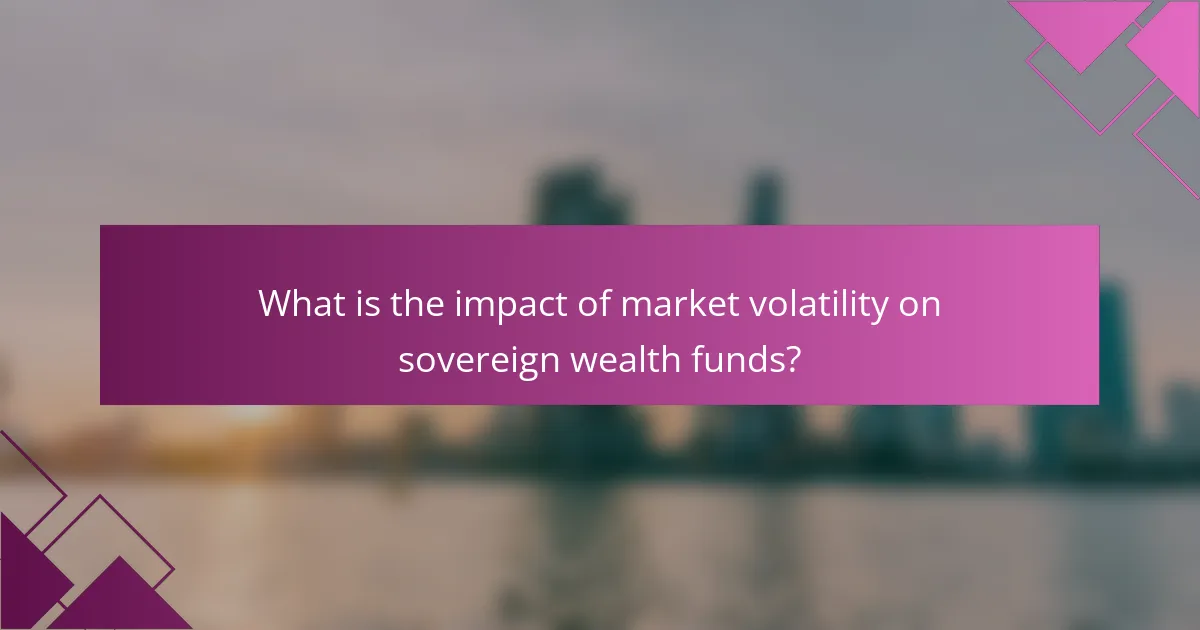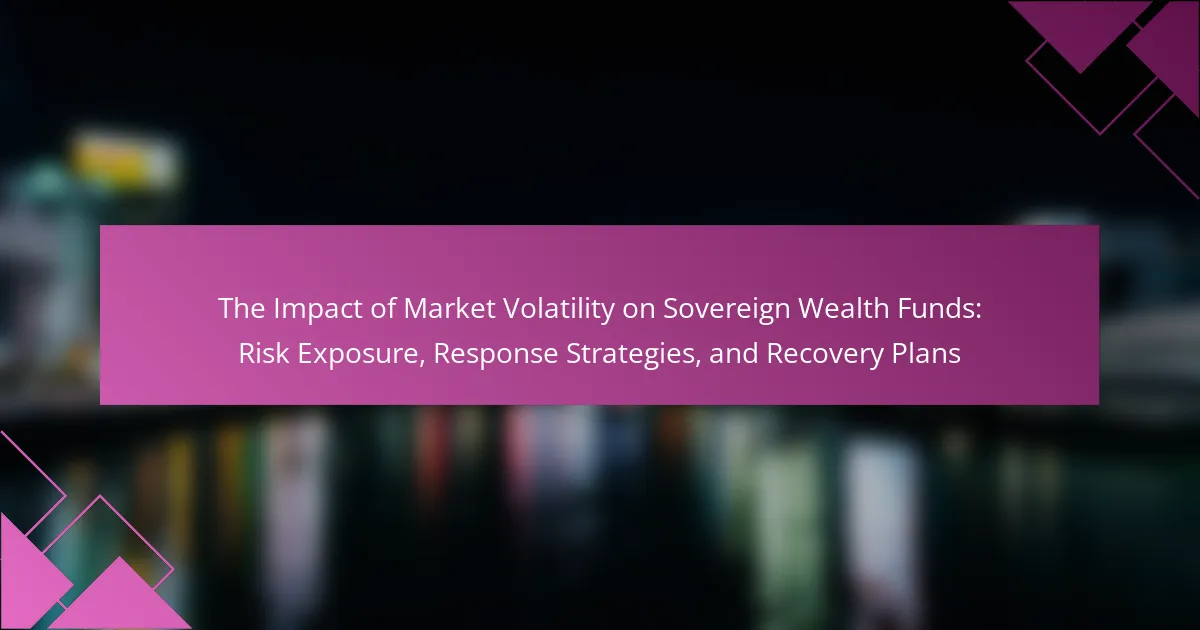
What is the impact of market volatility on sovereign wealth funds?
Market volatility significantly impacts sovereign wealth funds by affecting their investment returns and risk management strategies. Sovereign wealth funds typically invest in a diverse range of assets. When market volatility increases, the value of these investments can fluctuate widely. This can lead to reduced returns or even losses for the funds.
For example, during the 2008 financial crisis, many sovereign wealth funds experienced substantial declines in asset values. According to the International Monetary Fund, these funds lost approximately $150 billion in value during that period.
Additionally, market volatility forces sovereign wealth funds to reassess their risk exposure. They may shift their asset allocation to mitigate risks associated with volatile markets. This often involves increasing investments in safer assets or diversifying into different markets.
Overall, market volatility challenges sovereign wealth funds to adapt their strategies continually. This ensures they can protect their capital and achieve long-term financial objectives.
How does market volatility affect the risk exposure of sovereign wealth funds?
Market volatility increases the risk exposure of sovereign wealth funds. Fluctuations in asset prices can lead to significant losses in portfolio value. Sovereign wealth funds often invest in diverse asset classes, including equities and bonds. During periods of high volatility, the correlation between these assets may rise. This can reduce the effectiveness of diversification strategies. Increased market uncertainty can also lead to liquidity risks. Funds may struggle to sell assets without impacting market prices. Historical data shows that sovereign wealth funds experienced losses during major market downturns, such as the 2008 financial crisis. Such events highlight the vulnerability of these funds to market fluctuations.
What are the primary risks associated with market volatility for these funds?
The primary risks associated with market volatility for sovereign wealth funds include significant asset value fluctuations. These funds often invest in diverse asset classes, which can experience rapid price changes. Market volatility can lead to reduced returns on investments. This situation may also increase the cost of capital for these funds. Additionally, there is a risk of liquidity challenges during volatile periods. Investors may withdraw funds, leading to potential cash flow issues. Historical data shows that during financial crises, such as the 2008 recession, sovereign wealth funds faced substantial losses. These risks necessitate robust risk management strategies to mitigate exposure.
How does historical market volatility influence current risk management strategies?
Historical market volatility shapes current risk management strategies by informing decision-making processes. Analysts study past volatility patterns to predict potential future risks. This analysis helps in developing models that assess risk exposure more accurately. For example, during periods of high volatility, risk management strategies often incorporate higher capital reserves. Historical data shows that the 2008 financial crisis led to more conservative investment approaches in subsequent years. Additionally, lessons from past market downturns prompt the adoption of diversified asset allocations. This diversification aims to mitigate risks associated with specific sectors or asset classes. Overall, historical volatility serves as a critical reference point for refining current risk management frameworks.
What response strategies do sovereign wealth funds employ during periods of volatility?
Sovereign wealth funds employ several response strategies during periods of volatility. These strategies include diversification of assets to mitigate risk. By spreading investments across various sectors and geographies, funds reduce exposure to any single market downturn.
Additionally, they may increase cash reserves to take advantage of lower asset prices. This liquidity allows for opportunistic buying when markets are down. Some funds also adjust their investment horizons, shifting focus to long-term gains rather than short-term fluctuations.
Furthermore, they may engage in hedging strategies to protect against market declines. Using financial derivatives helps to offset potential losses. Historical data shows that during the 2008 financial crisis, many sovereign wealth funds adopted these strategies to safeguard their portfolios.
This approach not only preserves capital but also positions them for recovery when markets stabilize.
How do sovereign wealth funds assess their risk tolerance in volatile markets?
Sovereign wealth funds assess their risk tolerance in volatile markets through rigorous analysis and strategic frameworks. They utilize quantitative models to evaluate potential market fluctuations. Historical data is analyzed to identify patterns and trends. Stress testing is conducted to simulate extreme market conditions. This helps in understanding potential impacts on portfolio performance. Additionally, funds often establish risk limits based on investment objectives and time horizons. They engage in scenario analysis to predict outcomes under various market conditions. Diversification strategies are employed to mitigate risks associated with specific asset classes. These methods collectively enhance their ability to navigate market volatility effectively.
What role does diversification play in mitigating risk for these funds?
Diversification plays a crucial role in mitigating risk for sovereign wealth funds. By spreading investments across various asset classes, sectors, and geographical regions, these funds reduce exposure to any single economic event. This strategy helps to balance potential losses in one area with gains in another. Historical data shows that diversified portfolios tend to exhibit lower volatility than concentrated ones. For instance, during the 2008 financial crisis, diversified funds performed better than those heavily invested in specific sectors. Thus, effective diversification enhances stability and protects against market fluctuations.
What recovery plans are typically implemented by sovereign wealth funds post-volatility?
Sovereign wealth funds typically implement diversified investment strategies as recovery plans post-volatility. They often reallocate assets to reduce risk exposure. Increased focus on alternative investments, such as real estate or infrastructure, is common. Funds may also enhance liquidity to take advantage of market opportunities. Risk management frameworks are updated to reflect new market conditions. Historical data shows that funds that diversify tend to recover faster. For instance, the Norway Government Pension Fund Global shifted allocations after the 2008 financial crisis. This strategy helped them rebound effectively.
How do sovereign wealth funds adapt their investment strategies after market downturns?
Sovereign wealth funds adapt their investment strategies after market downturns by reallocating assets and diversifying portfolios. They often increase allocations to undervalued assets to capitalize on recovery potential. Additionally, funds may shift towards more stable investments, such as bonds or commodities, to mitigate risk. Some funds also enhance liquidity to take advantage of buying opportunities during downturns. Historical data shows that during the 2008 financial crisis, many sovereign wealth funds increased their investments in distressed assets, leading to significant long-term gains. This strategy reflects a proactive approach to adjusting risk exposure while aiming for future growth.
What indicators do funds monitor to gauge recovery in the market?
Funds monitor several key indicators to gauge recovery in the market. These indicators include economic growth rates, employment data, and consumer confidence indices. Additionally, funds analyze stock market performance and bond yields. They also consider inflation rates and central bank policies. Historical data shows that these indicators correlate with market recovery trends. For instance, rising GDP often signals a recovering economy. Employment growth typically reflects increased consumer spending. Monitoring these indicators helps funds make informed investment decisions.
How do sovereign wealth funds communicate their strategies and plans to stakeholders during volatility?
Sovereign wealth funds communicate their strategies and plans to stakeholders during volatility through transparent reporting and regular updates. They utilize formal communication channels such as annual reports and press releases. These documents often include performance metrics and strategic adjustments in response to market conditions. Additionally, funds may hold stakeholder meetings to discuss their outlook and risk management strategies. They leverage digital platforms for real-time updates, ensuring stakeholders stay informed. This approach fosters trust and confidence during uncertain times. Research shows that effective communication can mitigate stakeholder anxiety and enhance collaboration.
What best practices can sovereign wealth funds adopt to enhance resilience against market volatility?
Sovereign wealth funds can enhance resilience against market volatility by diversifying their investment portfolios. Diversification reduces risk by spreading investments across various asset classes and geographical regions. This strategy can help mitigate losses during market downturns, as different assets often react differently to economic changes.
Additionally, implementing a robust risk management framework is essential. This framework should include regular stress testing and scenario analysis to understand potential impacts of market fluctuations. Historical data indicates that funds employing such practices can better withstand financial shocks.
Furthermore, maintaining a long-term investment horizon allows sovereign wealth funds to ride out short-term volatility. Studies show that patience in investment strategies often leads to more favorable outcomes over time.
Lastly, investing in liquid assets can provide flexibility during market crises. Having readily available cash or cash-equivalents enables funds to capitalize on opportunities when markets recover.
The main entity of this article is sovereign wealth funds, which are investment funds owned by governments. The article examines the impact of market volatility on these funds, focusing on how it affects their investment returns, risk management strategies, and overall financial health. Key topics include the assessment of risk exposure during volatile periods, response strategies such as diversification and liquidity management, and recovery plans implemented after downturns. Additionally, the article highlights best practices for enhancing resilience against market fluctuations and the importance of transparent communication with stakeholders.
